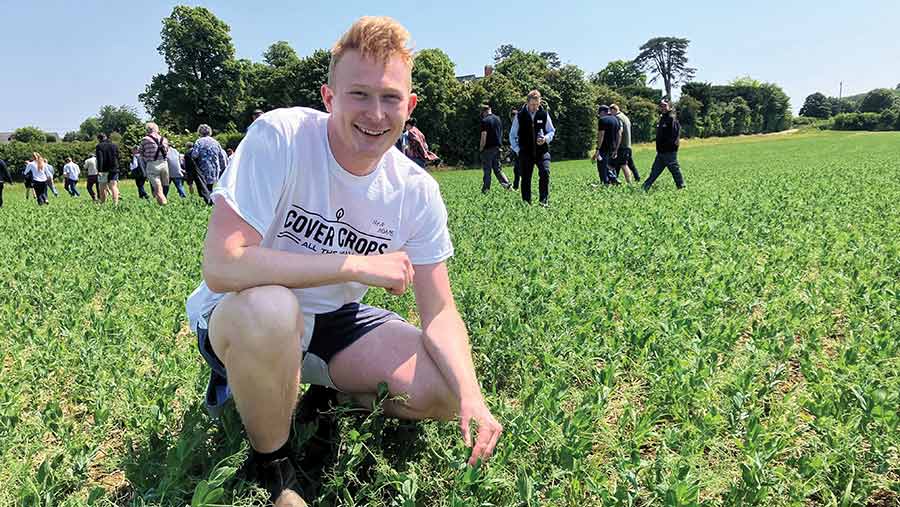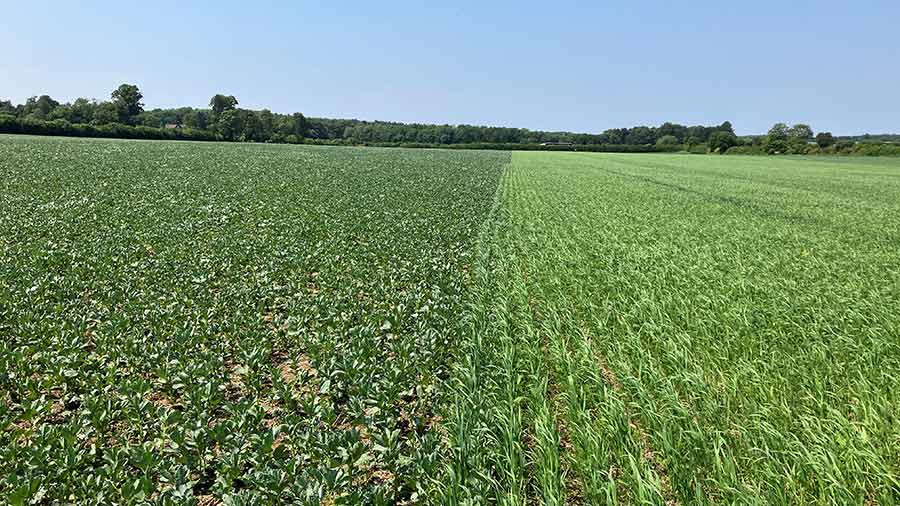How intercropping trial aims to eliminate chemical inputs
 Ben Adams © MAG/Emma Gillbard
Ben Adams © MAG/Emma Gillbard After winning a net-zero food and farming competition, Oxfordshire farmer Ben Adams is conducting a field-scale intercropping trial to assess which crop combinations perform best in terms of yield, quality and harvest ease.
Intercropping with legumes has so far completely eliminated artificial fertiliser and fungicide requirements, says Ben.
“No inputs have been applied or will be applied apart from the glyphosate desiccation of the prior cover crop.”
Now he hopes to increase land output.
See also: Farmers to reap slice of £5.9m Defra-funded pulse project
Already an enthusiast for field trials at Lower Farm, near Bicester, Ben entered the School of Sustainable Food and Farming net-zero competition which offers funding to farmers with a sustainable farming idea, system or process.
His three-year study project focuses on finding the value of intercropping with legumes across field-scale trials and was awarded more than £11,000.
Intercropping trial
A mix of peas, beans, vetch, oilseed rape, mustard, oats and barley were put to the test this spring in nine different cropping combinations across a 16ha area on the 380ha family farm.
The range of crop combinations will trial how best to maximise yield and quality while monitoring any issues with pests, weeds or disease.
Subsequent trial seasons will see him scale up the best-performing plots.
He hopes to not only cut inputs, but increase land output. Aiming for a 60% target yield of a monoculture crop, he sets his sight on a total land output of 120% where a bi-crop is grown.
This season saw him establish:
- Plot 1: Beans at 250kg/ha + oats at 35kg/ha + OSR at 5kg/ha
- Plot 2: Beans at 280kg/ha + OSR at 6kg/ha
- Plot 3: Oats at 130kg/ha + vetch at 6kg/ha
- Plot 4: Beans at 280kg/ha + oats at 40kg/ ha
- Plot 5: Barley at 150kg/ha + vetch at 6kg/ha
- Plot 6: Peas at 250kg/ha + OSR at 6kg/ha
- Plot 7: Peas at 220kg/ha + barley at 30kg/ha + mustard at 4kg/ha
- Plot 8: Peas at 250kg/ha + mustard at 6kg/ha
- Plot 9: Peas at 250kg/ha + barley at 40kg/ha

Intercropping trial © MAG/Emma Gillbard
Crop establishment
Crops were drilled on the 18 and 19 April, and sown in the same row with a 6m Horsch Avatar drill following an autumn-sown multispecies cover crop, which preceded a crop of winter wheat.
The cover crop was grazed by sheep and then sprayed off with 3 litres/ha of glyphosate.
A variety blend of beans, oats, barley and peas were used to increase the genetic diversity of crops on-farm, to better withstand pest and disease attack.
The varieties grown were:
- Beans: Lynx, Ghengis and Viper
- Oats: Merlin, Canyon and Aspen
- Barley: Laureate, Sassy and Diablo
- Peas: Carrington, Bluetime and Aviator.
End use
When it comes to harvest, Ben will use his conventional combine, but a compromise will need to be made to ensure optimum harvest for both crops.
“For example, with beans and oats, the concave will need to be set wide enough to not crack the beans but have the fan speed set low enough to not blow oats out the back of the combine,” says Ben.
The mix will be run through the farm’s three-screen rotary seed cleaner to separate the seed.
For the three-way intercrop, Ben predicts the grain will have to be run through the cleaner at least twice, which means a greater energy cost.
However, the input-cost saving through fertiliser and fungicides will outweigh the extra energy costs associated with seed separation.
Crops will be destined for the human consumption market if they meet the required grade; otherwise they will be sold for livestock feed.
A proportion of farm-saved seed will be kept to help cut seed costs for next season.
All straw will be chopped to return essential phosphorus, potassium and organic matter back to the soil.
After harvest, Ben plans to run through with a light set of discs to encourage a catch crop of volunteers, before planting a variety blend of winter wheat.
This will, hopefully, benefit from the nitrogen reserves in the soil from the range of leguminous crops previously grown.
If you are interested in visiting Ben’s intercropping trials, you can follow his video blog journey.
Industry partners for the project include: Morrisons, McDonald’s, Trinity Ag Tech, Trinity Global Farm Pioneers and Bradford Estates.
Current establishment costs for the intercropping trial at Lower Farm, Oxfordshire |
||||||||
|
Crop Mix |
Seed cost (£/kg) |
Total seed cost (£/ha) |
Previous cover crop (£/ha) |
Glyphosate cover crop destruction (£/ha) |
Spraying (£/ha) |
Drilling (£/ha) |
Rolling (£/ha) |
Current total (£/ha) |
|
Beans Oats OSR |
0.53 0.41 14 |
216 |
18 |
22 |
10 |
80 |
10 |
356 |
|
Beans OSR |
0.53 14 |
232 |
18 |
22 |
10 |
80 |
10 |
372 |
|
Oats Vetch |
3 0.41 |
71 |
18 |
22 |
10 |
80 |
10 |
211 |
|
Beans Oats |
0.53 0.41 |
164 |
18 |
22 |
10 |
80 |
10 |
304 |
|
Barley Vetch |
3 0.48 |
90 |
18 |
22 |
10 |
80 |
10 |
230 |
|
Peas OSR |
0.48 14 |
204 |
18 |
22 |
10 |
80 |
10 |
344 |
|
Peas Barley Mustard |
0.48 0.48 3.40 |
134 |
18 |
22 |
10 |
80 |
10 |
274 |
|
Peas Mustard |
0.48 3.40 |
140 |
18 |
22 |
10 |
80 |
10 |
281 |
|
Peas Barley |
0.48 0.48 |
139 |
18 |
22 |
10 |
80 |
10 |
280 |
Potential Sustainable Farming Incentive payments
By intercropping, direct-drilling and eliminating insecticides, Ben Adams is paving the way for a potential £295-£410/ha Sustainable Farming Incentive (SFI) payment made up of:
- £55/ha companion cropping payment
- £45/ha no-insecticide payment
- Between £50-£125/ha via the no-till/direct-drilling criteria
- Between £10-£50/ha via the precision-farming-approaches criteria
- £129/ha winter cover crop payment
- £6/ha via the soil assessment option.

